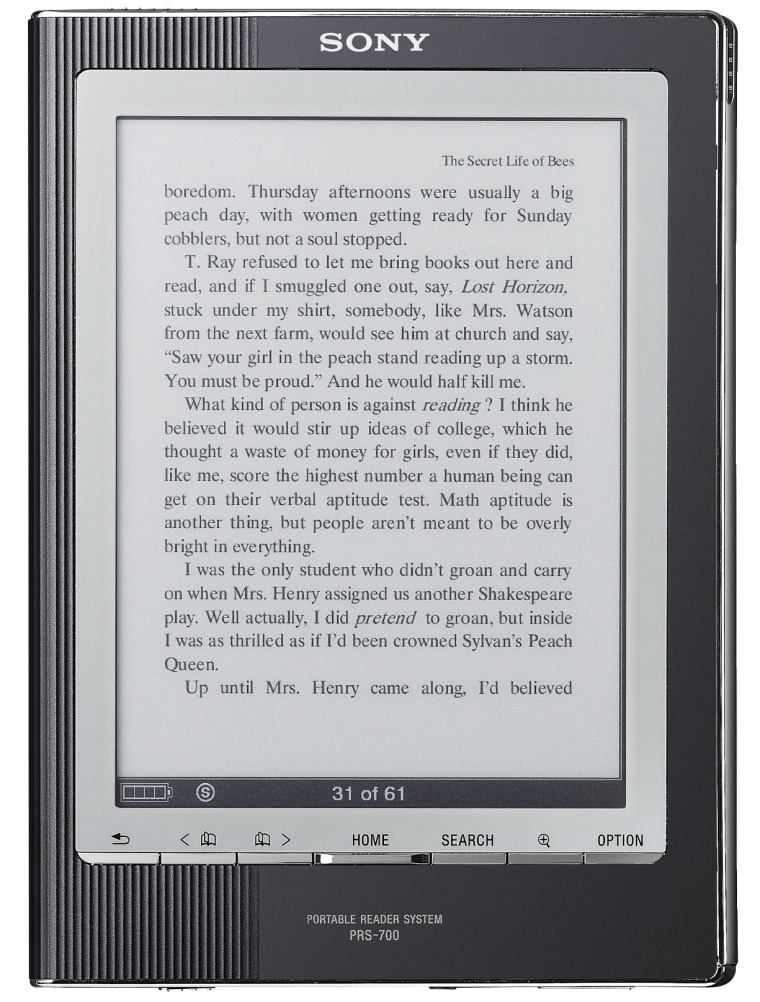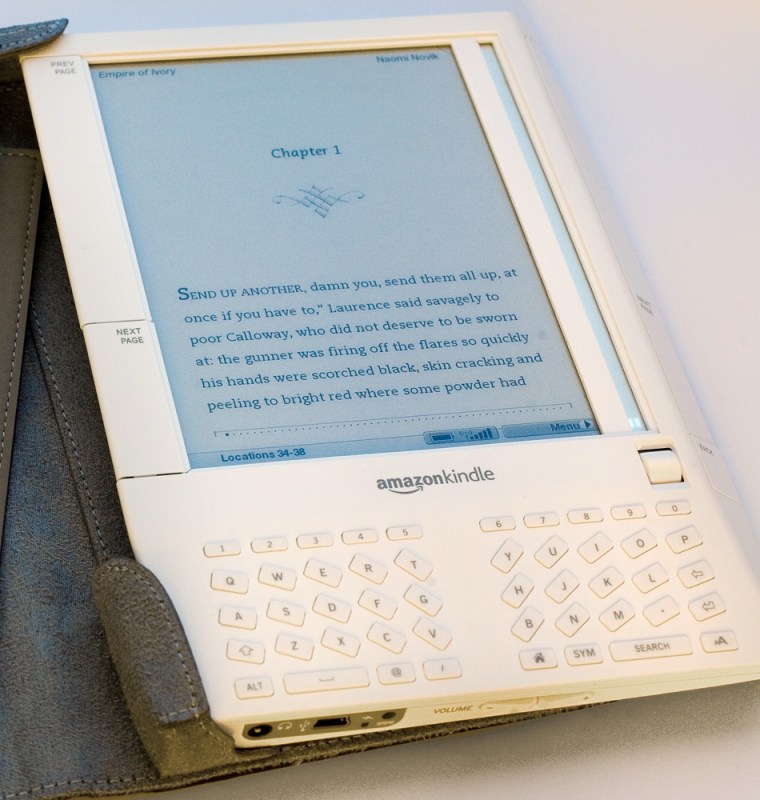Tech holiday gift checklist: LCD TV — maybe. New BlackBerry or iPhone — possible. E-reader — are you kidding?
No, not kidding. While they're unlikely to be high on many shoppers’ lists, Sony’s recent e-reader, the PRS-700, and Amazon’s Kindle, out for more than a year, are starting to generate interest. Whether they’ll generate sales remains to be seen.
Their relatively high prices — $399.99 for the Sony and $359 for the Kindle — won’t help either one in a season of frugality. But for those who are voracious book readers, travelers or students, the devices’ costs could be outweighed by the their ability to lighten the schlep load and save money on book-buying.
New York Times’ best-selling hardcover books generally cost $9.99 for the Kindle, and $11.99 at Sony’s eBook Store. Both prices are significantly lower than print versions of books.
Easier on the eyes
Both Sony’s Reader Digital Book, as it’s called, and the Kindle use a technology called E Ink. It helps digital pages look real, and is easier on the eyes for longer periods of reading.
“All of us can read short PDFs and e-mail on our BlackBerrys and our computers,” said Brennan Mullin, Sony Electronics vice president of audio. “But when you’re reading a novel or reading research materials and sitting for one or two hours, the experience on those devices is not great, the battery life is limited, and it’s hard on your eyes.”
Those are some of the reasons devices like smartphones, iPods and portable game players may not be the best options for reading books, although they certainly can be used for that.
“Cell phone screens are undeniably getting larger, and may emerge as a better fit for shorter-form content in the near future, such as magazine features blogs,” said Ross Rubin, director of industry analysis for The NPD Group market research firm.
“The Sony Reader and the Amazon Kindle have certainly made progress. But, there’s going to be a limited market for a dedicated device that reads books simply because a relatively small percentage of the U.S. population are avid enough readers to justify purchases of such a device, even as prices come down, which they will continue to do.”
For e-readers to become “a mass-market item,” prices will need to drop, and they’ll “need to be embraced by the education market” to succeed, he believes.
Some of that is starting to happen. Sony says books can now be downloaded to its readers from some public libraries around the country. And, this fall, the company donated 100 of its readers to Penn State University’s libraries to see how students use the device for research projects, as well as for classroom and leisure reading.
Differences between Sony, Amazon
Amazon, which constantly releases statistics on everything from on who’s buying what and when — down to the hour — has not publicly shared information about Kindle sales.
The company recently noted that Kindle is sold out, “due to heavy customer demand,” and said orders placed now will not be delivered until after Christmas Eve.
Research firm iSuppli said earlier this year that the Kindle and Sony readers have "proven there is a viable market for eBooks," with shipments of all eBooks expected to reach 1 million units in 2008.
“It's possible that Amazon's Kindle and Sony's Reader could do for eBooks what Apple's iPod did for MP3 players,” said Vinita Jakhanwal, principal analyst for mobile displays at iSuppli, said in a report.
Sony’s first digital reader was released in Japan, then in the United States in 2006. The company has another reader, the PRS-505, which retails for $299.

One of the main differences between it and the newer model, the PRS-700, is that the PRS-700 uses a touchscreen and readers can highlight, annotate and search for words in books.
The biggest difference between Sony’s readers and the Kindle is how books get onto the devices.
The Kindle uses a wireless connection over Sprint’s phone data network to deliver books to the device, so it can be done from just about anywhere in the country, except from Montana and Alaska. No computer is necessary, and there is no extra charge for the connection.
Sony’s readers download books to a PC. The Sony Reader comes with a USB cable, which is connected to the PC to transfer books to the device.
Both the Sony and Kindle readers are fairly lightweight, between 10 to 11 ounces, and have 6-inch display screens, adjustable font sizes and long-lasting batteries of a week or more (less time with the Kindle if you use the wireless connection frequently).
One of the Kindle's draws is that customers can get discounts on suscriptions for newspapers and magazines, including The New York Times, Newsweek and Time.
So far, Amazon has more than 190,000 books for the Kindle; Sony’s eBook Store has 57,000, with more than 100,000 expected by the end of the year, said a spokeswoman. She added that Reader users can also buy and download books from “lots of places,” both free and paid, including Manybooks.net, Gutenberg.com and Fictionwise.com.
Book publishers ramp up
Publishers are ramping up the number of digital books in their collections. Random House, with more than 8,000 electronic books, said recently it plans to increase its digital holdings to nearly 15,000 volumes.
“More people are doing things on screens every day, and I don’t see valid arguments why trade books or consumer books would be fundamentally excepted from that trend,” said Matt Schatz of Random House Technology Services.
“My sense is that most of the time when people buy a book, ultimately it’s to read the text, to learn something new, to fall in love with a character, to be transported to a different time and place.” There’s no reason that can’t happen on a screen, especially with display technology improving, he said.
“There are lots of reasons print books will remain, such as coffee table books or books with beautiful images or pictures. And clearly, there are also people who like having books on their shelves. They like the warmth it brings to a room, or what the books say about them.”
Books, both electronic and printed, will continue to thrive, “just as there’s a healthy population still buying CDs for music,” along with digital music files, Schatz said.
Sony and Amazon’s products are the two leading digital readers available in the United States. In Europe, iRex Technologies, a Philips Electronics company spin-off, has the iLiad Book Edition, a digital reader that is being sold by Borders in the United Kingdom.
Sony’s e-readers are sold at Borders stores in the United States, as well as at Sony retail stores and various chains. Because travelers are an obvious market for e-readers, Sony will place representatives, with e-readers in hand, at Grand Central Station in the weeks ahead to promote their devices.
The company is pushing its “see it before you buy” advantage that the Kindle does not have quite as handily.
'See a Kindle in Your City'
Amazon has a "See A Kindle in Your City" program, where those who want to see the device can link up with Kindle owners in their areas. And, Kindle owners are quite passionate about the device.
“In November, I read eight books, three short stories and my almost-daily New York Times,” using the Kindle, said Leslie H. Nicoll, a nurse from Portland, Maine.
“That is probably more books than I read in all of 2007. I love the Kindle because it has gotten me reading like I did in the ‘old’ days — when my eyes were better and my wrists didn't get tired from holding a book.”
Nicoll, who is also the editor of two professional nursing journals and an e-book publisher, answers questions from other Kindle owners at “Kindle Discussions” area of Amazon.com. She also wrote “The Amazon Kindle FAQ” e-book ($1.59), sold through Amazon.
Kindle users can get discounted subscriptions on various publications, including The New York Times, a big draw for Nicoll.
“My New York Times subscription costs $168 a year vs. paying $665 a year for a paper subscription here in Maine,” she said. “That’s a huge savings.”
